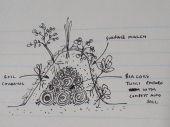
 7
7




 4
4




 3
3




 2
2




 2
2




shauna carr wrote:They are terra cotta with a cement inner core, and that core ends up preventing the water from getting through, basically. I've had more than one business that I asked about their terra cotta pots, they assured me up and down were 'real' terra cotta. I tried them, didn't really see much benefit and ended up digging them up, and then a big windstorm came by and blew them over, shattering them, and they all had cement in the middle of the terra cotta. :-/
 2
2




Phil Stevens wrote:Word has it that the really good ones are made from clay containing sawdust, rice hulls, or some other lightweight fine biomass that burns away on firing and leaves voids that the water can seep through. A friend of ours is taking pottery classes and she plans to do some experimenting to find what sort of mix works best.




 2
2




 1
1




Anne Fletcher wrote:Hey all! I'm adding an update to my post above.
Last week we had one of the hottest weeks ever here in California. It was HOT! We went to the mountains overnight to escape the worst of the heat and I expected to find totally dead lettuce when we returned. But the lettuces I had planted around the new ollas (pictured above in the first post) were totally fine, perky even!
It also helps that these are heat tolerant varieties, Australian yellow (https://ortakitchengarden.com/products/australian-yellow-lettuce-seeds) and Brown goldring (https://www.wildgardenseed.com/product_info.php?products_id=84).
Here are pictures of my lettuce (watered by ollas) after 2 really, really hot days:

|
These are the worst of times and these are the best of times. And this is the best tiny ad:
The new kickstarter is now live!
https://www.kickstarter.com/projects/paulwheaton/garden-cards
|






